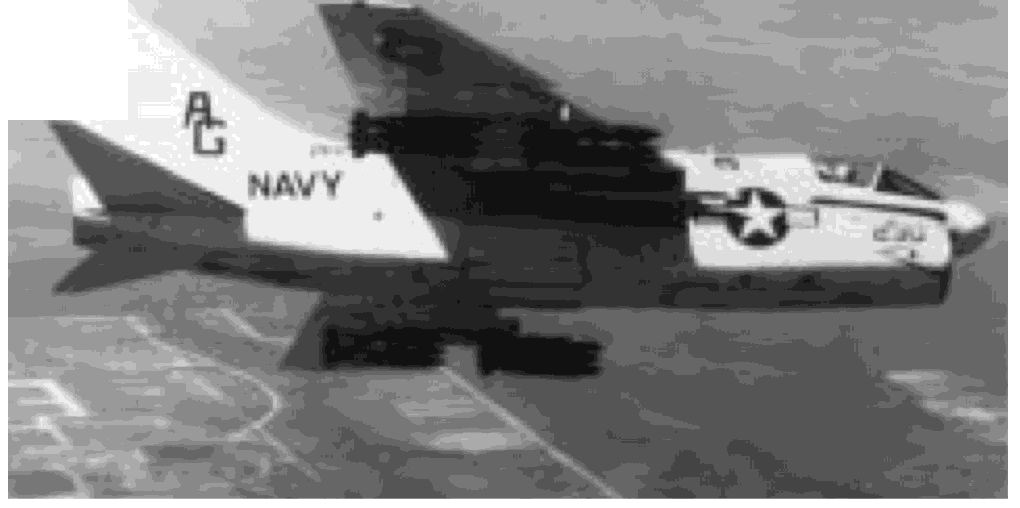
248
UNITED STATES NAVAL AVIATION
1910-1995
1962-Contin ued
12 April
The F4H-l made a clean sweep of world
time-to-climb records as Lieutenant Commander Del
W. Nordberg piloted a Phantom II at Point Mugu,
Calif., on a climb to 30,000 meters in 371.43 seconds.
Speed attained was better than 3 miles per minute,
straight up.
30 April
The Naval Air Research and Development
Activities Command was disestablished and responsi-
bility for overall management and coordination of the
aeronautical research and development activities in the
Third and Fourth Naval Districts was returned to the
Bureau of Naval Weapons.
10 May
A Sparrow III fired from an F4H-l scored a
direct hit in a head-on attack on a Regulus II missile
while both were at supersonic speed. The intercep-
tion, made in the test range of the Naval Air Missile
Center at Point Mugu, Calif., was the first successful
head-on attack made by an air-launched weapon on a
surface launched guided missile.
22 May
The Navy's first space satellite command,
the Navy Astronautics Group, was established at the
Pacific Missile Range Headquarters, Point Mugu, Calif.,
under command of Commander James C. Quillen, Jr.
In addition to its other duties, the new command was
given responsibility for operating the Transit
Navigational System being developed by the Navy for
the Department of Defense.
24 May
Lieutenant Commander M. Scott
Carpenter in
Aurora
7 was launched into orbit from
Cape Canaveral, Fla., on the second U.S. manned
orbital flight. Upon completing three orbits he
returned to earth, landing in the Atlantic 200 miles
beyond the planned impact area. He was located
by a Navy P2V, assisted by para-rescue men,
dropped from an Air Force RC-54 and, after almost
three hours in the water, picked up by an HSS heli-
copter from
Intrepid
and returned safely to the car-
rier. His capsule was retrieved by
John R. Pierce
(DD 753).
29 May
Vice Admiral Patrick N. 1. Bellinger, USN
(Ret.), died in Clifton Forge, Va. His long and distin-
guished career as Naval Aviator No.8 began on 26
November 1912 when he reported for flight training at
Annapolis, Md., and ended with his retirement 1
October 1947 while serving on the General Board. As
one of the pioneers in Naval Aviation, he conducted
many experiments, scored a number of "firsts" and
made several record flights.
1 June
The final report on the titanium alloy sheet
rolling program was issued by the Materials Advisory
Board of the National Research Council, thereby termi-
nating this program as a formally organized effort.
Achievements of the program during the six years
included acquiring metallurgical and engineering data
for a number of titanium alloys and familiarizing the
aerospace industry with their properties and methods
of fabrication. High strength, heat-treated sheet alloys
developed under this program were soon utilized in a
number of aircraft including the A-7, later models of
the F-4, the Air Force SR-71 and in deep submergence
vehicles used in oceanographic research. The success
of this effort also led to the establishment of a similar
refractory metal sheet rolling program to develop met-
als for use at extremely high temperatures.
1'1
,.
A-7 attack plane carries bombs and missiles NH69970
26 June
The 1,500-mile-range Polaris A-2 missile
became operational as
Ethan Allan
(SSBN 608) depart-
ed Charleston, S.c. carrying 16 of the A-2 missiles.
29 June
A Polaris missile was fired 1,400 miles
down range from Cape Canaveral, Fla., carrying the
new bullet-nose shape to be used in the A-3 advanced
Polaris. The first flight model of the A-3 was success-
fully fired from the same base on 7 August 1962.
1 July
The commands Fleet Air Patuxent and Naval
Air Bases, Potomac River Naval Command were estab-
lished and assigned as additional duty to Commander
Naval Air Test Center, Patuxent River, Md.
1
August
Squadrons of the Naval Air Reserve that
had been called up in October 1961, were released to
inactive duty, reducing the strength of the naval air
operating forces by 18 squadrons and 3,995 officers
and men.
 |
14 |
 |